University Business Environment Report: Unilever, Unit 1
VerifiedAdded on 2023/01/12
|12
|3791
|43
Report
AI Summary
This report provides a comprehensive analysis of Unilever's business environment, focusing on internal and external factors influencing its operations. It begins by exploring the types, size, and scope of organizations, differentiating between private, public, and voluntary companies, with specific examples like NHS and Oxfam. The report then delves into the positive and negative impacts of the macro environment, including political, economic, social, technological, legal, and environmental factors, on Unilever's business. A SWOT analysis is included to assess the company's strengths, weaknesses, opportunities, and threats, highlighting how these internal factors interrelate with external macro factors. The report emphasizes the importance of understanding the business environment for effective decision-making and achieving a competitive advantage, concluding with key insights into Unilever's strategic positioning in the market.
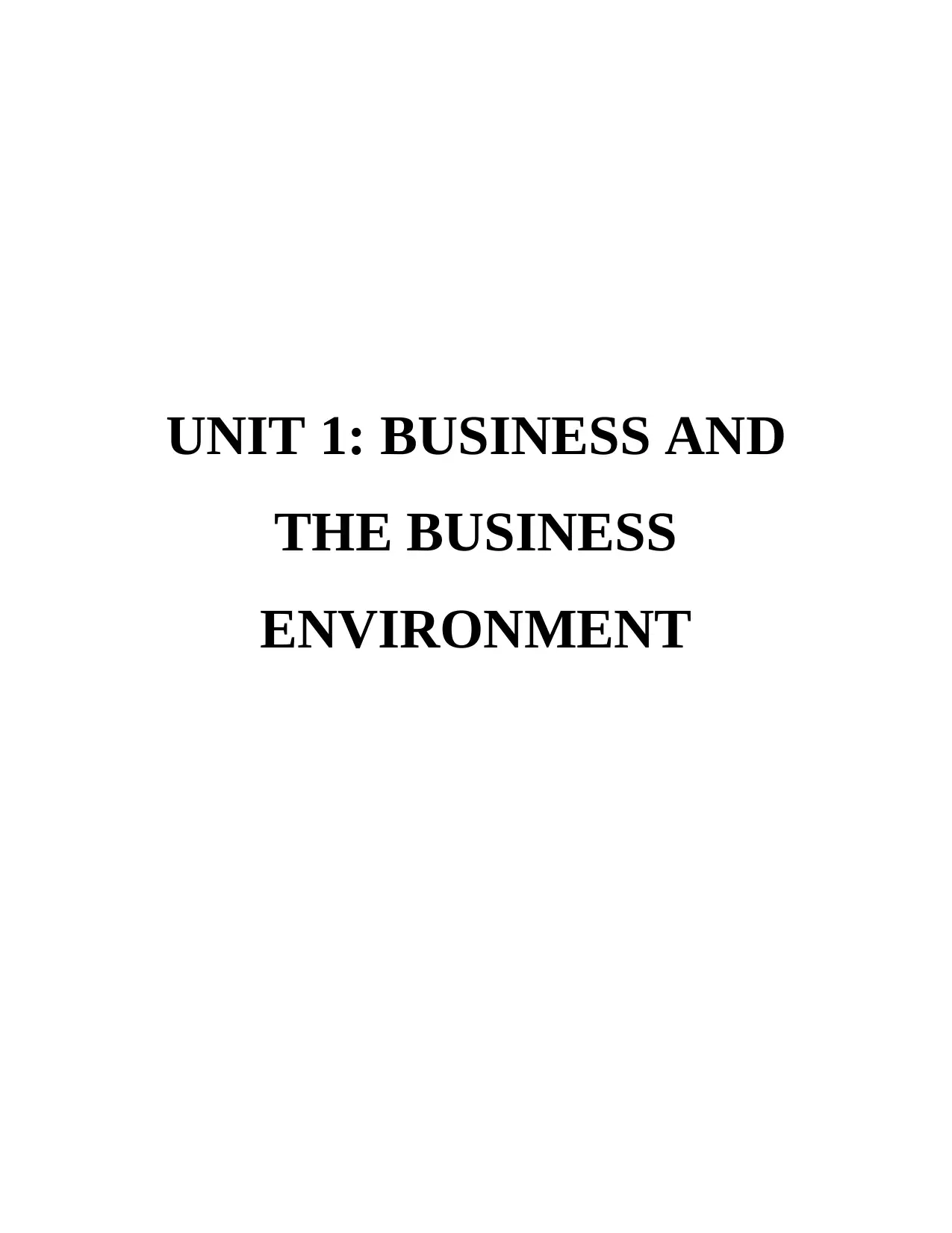
UNIT 1: BUSINESS AND
THE BUSINESS
ENVIRONMENT
THE BUSINESS
ENVIRONMENT
Paraphrase This Document
Need a fresh take? Get an instant paraphrase of this document with our AI Paraphraser
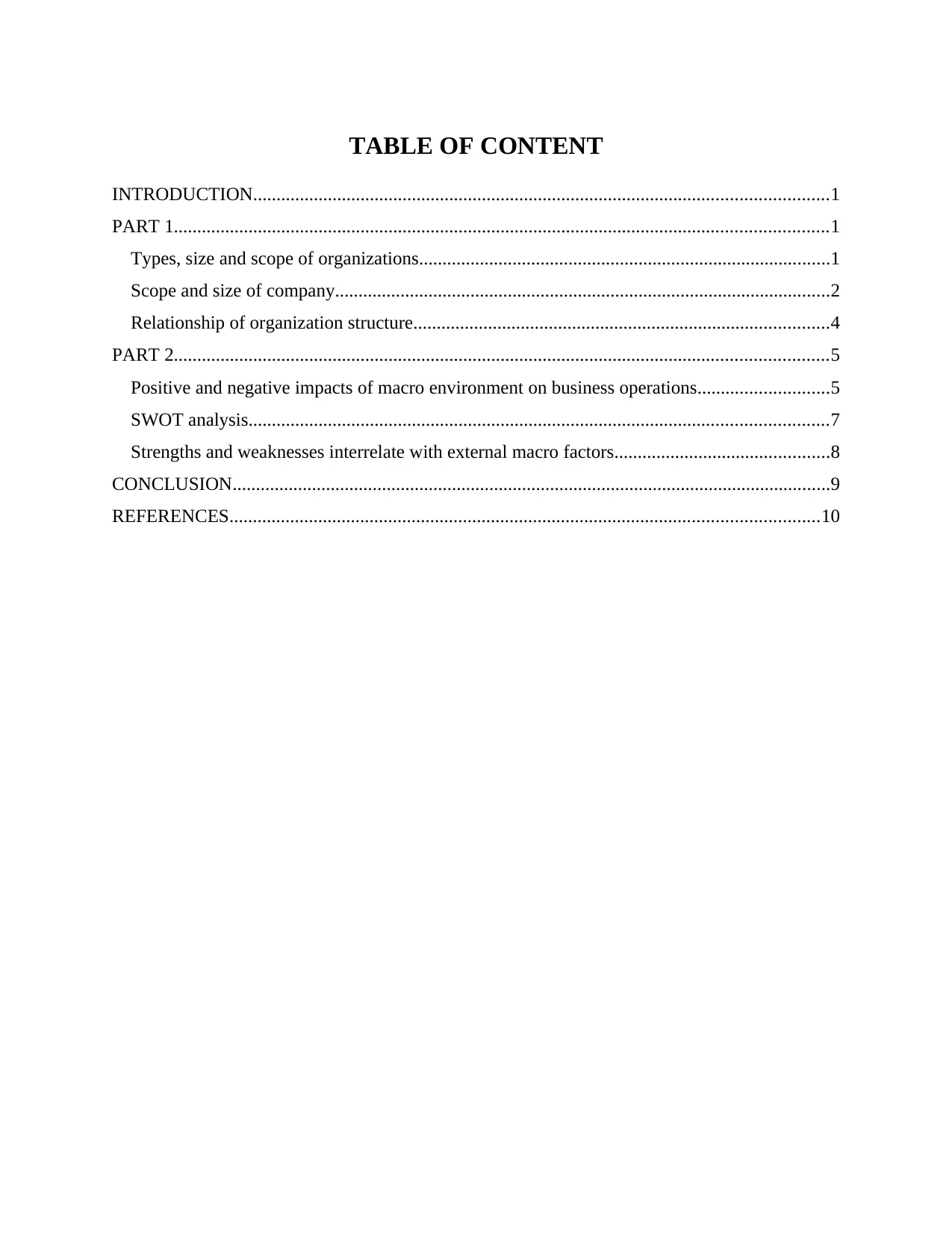
TABLE OF CONTENT
INTRODUCTION...........................................................................................................................1
PART 1............................................................................................................................................1
Types, size and scope of organizations........................................................................................1
Scope and size of company..........................................................................................................2
Relationship of organization structure.........................................................................................4
PART 2............................................................................................................................................5
Positive and negative impacts of macro environment on business operations............................5
SWOT analysis............................................................................................................................7
Strengths and weaknesses interrelate with external macro factors..............................................8
CONCLUSION................................................................................................................................9
REFERENCES..............................................................................................................................10
INTRODUCTION...........................................................................................................................1
PART 1............................................................................................................................................1
Types, size and scope of organizations........................................................................................1
Scope and size of company..........................................................................................................2
Relationship of organization structure.........................................................................................4
PART 2............................................................................................................................................5
Positive and negative impacts of macro environment on business operations............................5
SWOT analysis............................................................................................................................7
Strengths and weaknesses interrelate with external macro factors..............................................8
CONCLUSION................................................................................................................................9
REFERENCES..............................................................................................................................10
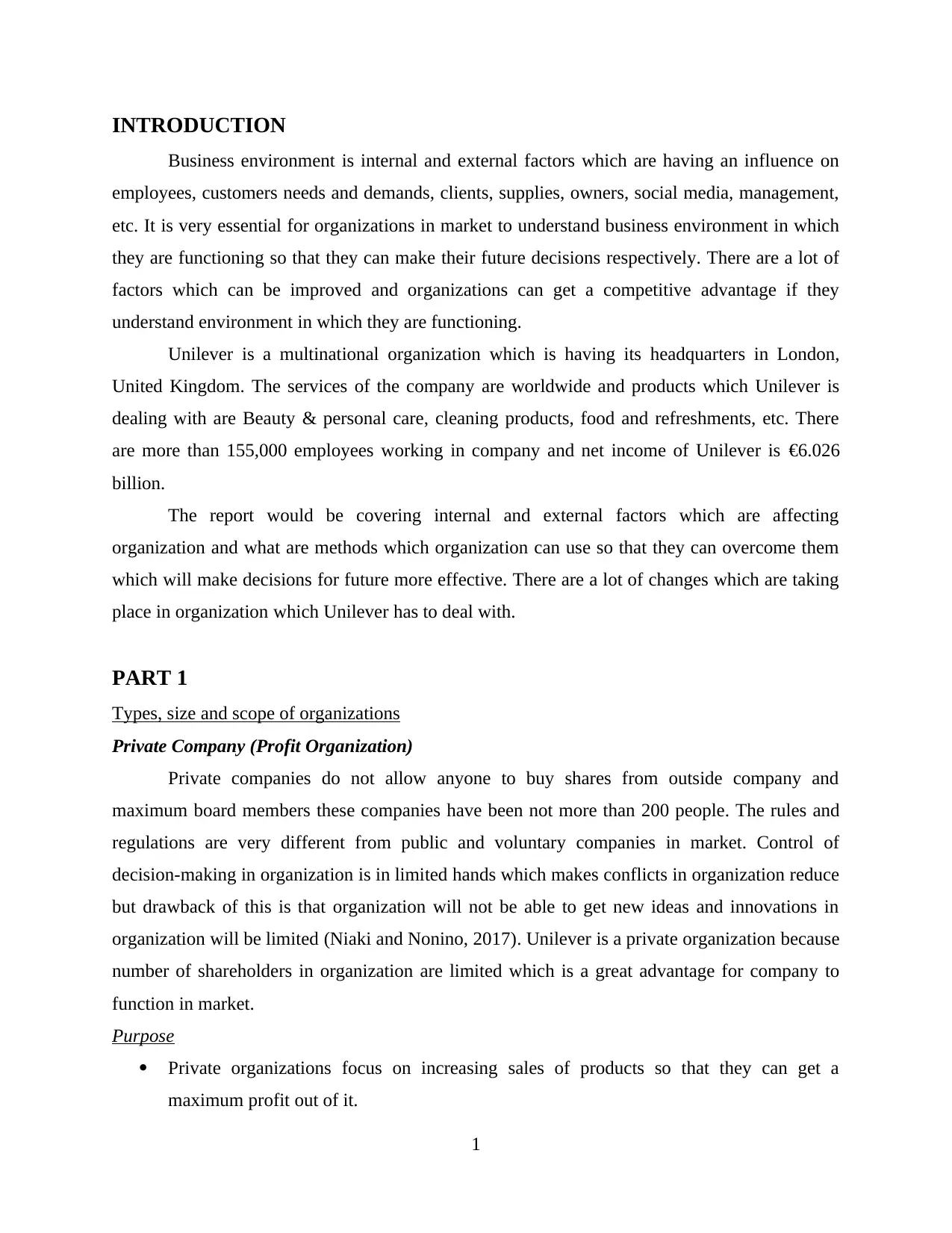
INTRODUCTION
Business environment is internal and external factors which are having an influence on
employees, customers needs and demands, clients, supplies, owners, social media, management,
etc. It is very essential for organizations in market to understand business environment in which
they are functioning so that they can make their future decisions respectively. There are a lot of
factors which can be improved and organizations can get a competitive advantage if they
understand environment in which they are functioning.
Unilever is a multinational organization which is having its headquarters in London,
United Kingdom. The services of the company are worldwide and products which Unilever is
dealing with are Beauty & personal care, cleaning products, food and refreshments, etc. There
are more than 155,000 employees working in company and net income of Unilever is €6.026
billion.
The report would be covering internal and external factors which are affecting
organization and what are methods which organization can use so that they can overcome them
which will make decisions for future more effective. There are a lot of changes which are taking
place in organization which Unilever has to deal with.
PART 1
Types, size and scope of organizations
Private Company (Profit Organization)
Private companies do not allow anyone to buy shares from outside company and
maximum board members these companies have been not more than 200 people. The rules and
regulations are very different from public and voluntary companies in market. Control of
decision-making in organization is in limited hands which makes conflicts in organization reduce
but drawback of this is that organization will not be able to get new ideas and innovations in
organization will be limited (Niaki and Nonino, 2017). Unilever is a private organization because
number of shareholders in organization are limited which is a great advantage for company to
function in market.
Purpose
Private organizations focus on increasing sales of products so that they can get a
maximum profit out of it.
1
Business environment is internal and external factors which are having an influence on
employees, customers needs and demands, clients, supplies, owners, social media, management,
etc. It is very essential for organizations in market to understand business environment in which
they are functioning so that they can make their future decisions respectively. There are a lot of
factors which can be improved and organizations can get a competitive advantage if they
understand environment in which they are functioning.
Unilever is a multinational organization which is having its headquarters in London,
United Kingdom. The services of the company are worldwide and products which Unilever is
dealing with are Beauty & personal care, cleaning products, food and refreshments, etc. There
are more than 155,000 employees working in company and net income of Unilever is €6.026
billion.
The report would be covering internal and external factors which are affecting
organization and what are methods which organization can use so that they can overcome them
which will make decisions for future more effective. There are a lot of changes which are taking
place in organization which Unilever has to deal with.
PART 1
Types, size and scope of organizations
Private Company (Profit Organization)
Private companies do not allow anyone to buy shares from outside company and
maximum board members these companies have been not more than 200 people. The rules and
regulations are very different from public and voluntary companies in market. Control of
decision-making in organization is in limited hands which makes conflicts in organization reduce
but drawback of this is that organization will not be able to get new ideas and innovations in
organization will be limited (Niaki and Nonino, 2017). Unilever is a private organization because
number of shareholders in organization are limited which is a great advantage for company to
function in market.
Purpose
Private organizations focus on increasing sales of products so that they can get a
maximum profit out of it.
1
⊘ This is a preview!⊘
Do you want full access?
Subscribe today to unlock all pages.

Trusted by 1+ million students worldwide
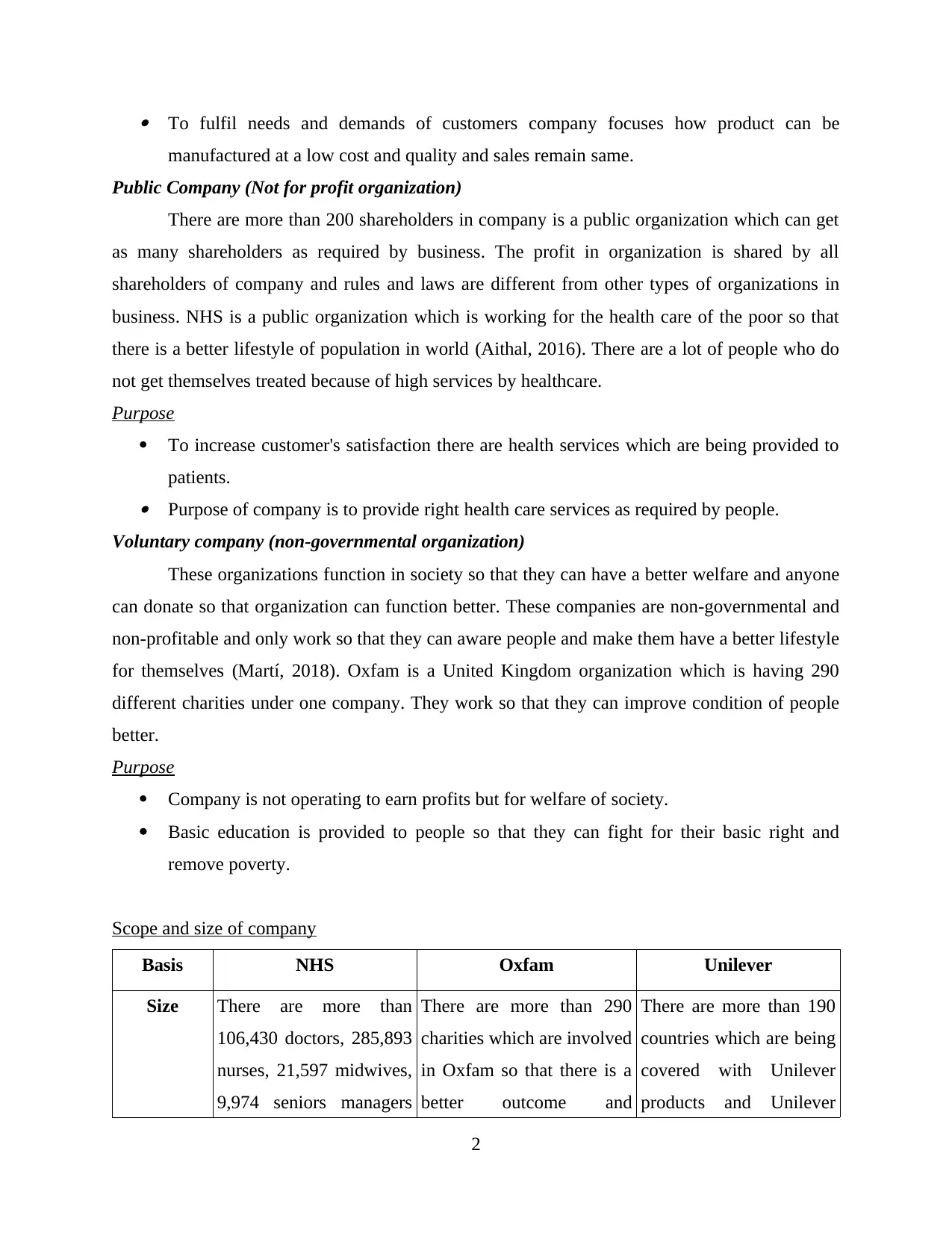
To fulfil needs and demands of customers company focuses how product can be
manufactured at a low cost and quality and sales remain same.
Public Company (Not for profit organization)
There are more than 200 shareholders in company is a public organization which can get
as many shareholders as required by business. The profit in organization is shared by all
shareholders of company and rules and laws are different from other types of organizations in
business. NHS is a public organization which is working for the health care of the poor so that
there is a better lifestyle of population in world (Aithal, 2016). There are a lot of people who do
not get themselves treated because of high services by healthcare.
Purpose
To increase customer's satisfaction there are health services which are being provided to
patients. Purpose of company is to provide right health care services as required by people.
Voluntary company (non-governmental organization)
These organizations function in society so that they can have a better welfare and anyone
can donate so that organization can function better. These companies are non-governmental and
non-profitable and only work so that they can aware people and make them have a better lifestyle
for themselves (Martí, 2018). Oxfam is a United Kingdom organization which is having 290
different charities under one company. They work so that they can improve condition of people
better.
Purpose
Company is not operating to earn profits but for welfare of society.
Basic education is provided to people so that they can fight for their basic right and
remove poverty.
Scope and size of company
Basis NHS Oxfam Unilever
Size There are more than
106,430 doctors, 285,893
nurses, 21,597 midwives,
9,974 seniors managers
There are more than 290
charities which are involved
in Oxfam so that there is a
better outcome and
There are more than 190
countries which are being
covered with Unilever
products and Unilever
2
manufactured at a low cost and quality and sales remain same.
Public Company (Not for profit organization)
There are more than 200 shareholders in company is a public organization which can get
as many shareholders as required by business. The profit in organization is shared by all
shareholders of company and rules and laws are different from other types of organizations in
business. NHS is a public organization which is working for the health care of the poor so that
there is a better lifestyle of population in world (Aithal, 2016). There are a lot of people who do
not get themselves treated because of high services by healthcare.
Purpose
To increase customer's satisfaction there are health services which are being provided to
patients. Purpose of company is to provide right health care services as required by people.
Voluntary company (non-governmental organization)
These organizations function in society so that they can have a better welfare and anyone
can donate so that organization can function better. These companies are non-governmental and
non-profitable and only work so that they can aware people and make them have a better lifestyle
for themselves (Martí, 2018). Oxfam is a United Kingdom organization which is having 290
different charities under one company. They work so that they can improve condition of people
better.
Purpose
Company is not operating to earn profits but for welfare of society.
Basic education is provided to people so that they can fight for their basic right and
remove poverty.
Scope and size of company
Basis NHS Oxfam Unilever
Size There are more than
106,430 doctors, 285,893
nurses, 21,597 midwives,
9,974 seniors managers
There are more than 290
charities which are involved
in Oxfam so that there is a
better outcome and
There are more than 190
countries which are being
covered with Unilever
products and Unilever
2
Paraphrase This Document
Need a fresh take? Get an instant paraphrase of this document with our AI Paraphraser
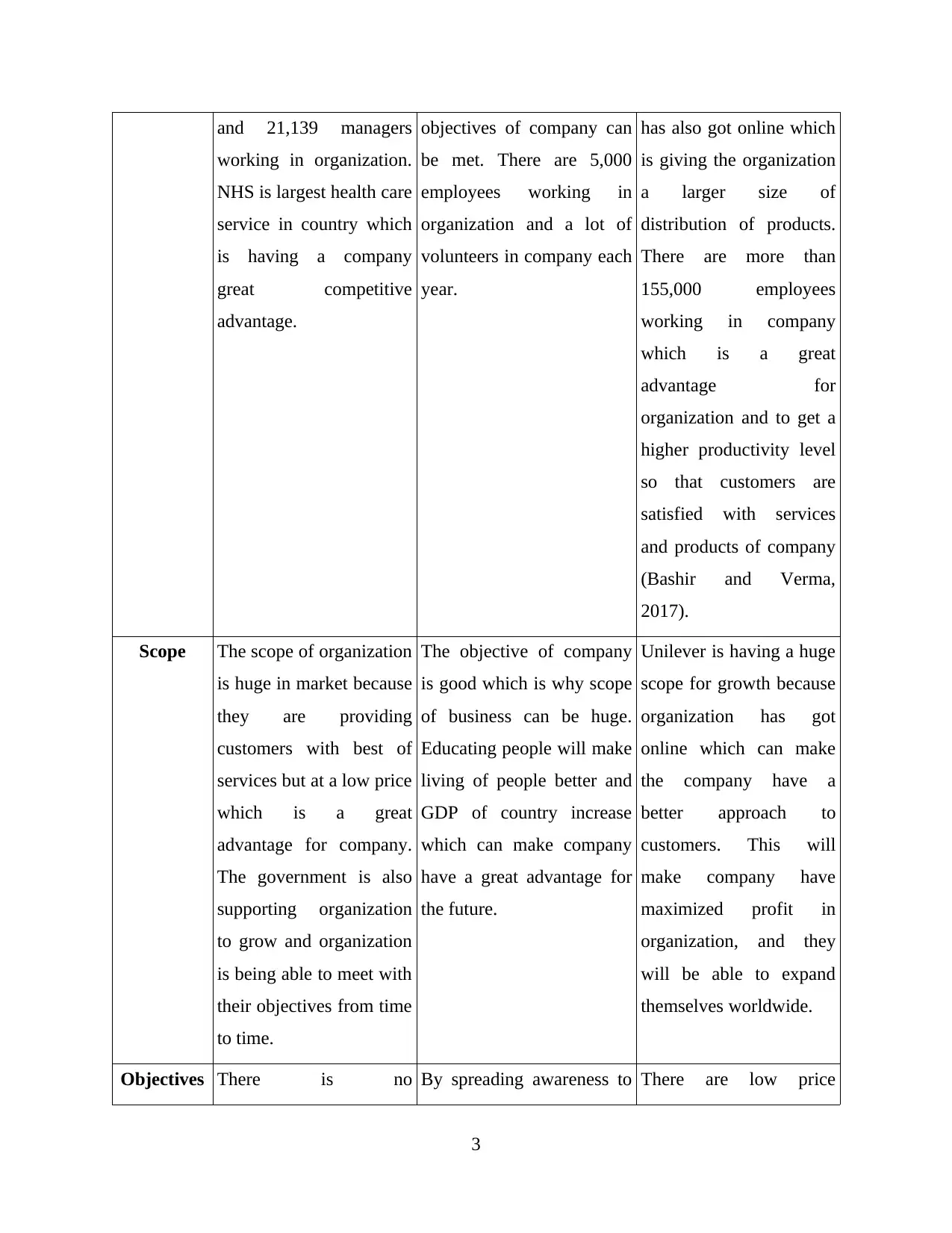
and 21,139 managers
working in organization.
NHS is largest health care
service in country which
is having a company
great competitive
advantage.
objectives of company can
be met. There are 5,000
employees working in
organization and a lot of
volunteers in company each
year.
has also got online which
is giving the organization
a larger size of
distribution of products.
There are more than
155,000 employees
working in company
which is a great
advantage for
organization and to get a
higher productivity level
so that customers are
satisfied with services
and products of company
(Bashir and Verma,
2017).
Scope The scope of organization
is huge in market because
they are providing
customers with best of
services but at a low price
which is a great
advantage for company.
The government is also
supporting organization
to grow and organization
is being able to meet with
their objectives from time
to time.
The objective of company
is good which is why scope
of business can be huge.
Educating people will make
living of people better and
GDP of country increase
which can make company
have a great advantage for
the future.
Unilever is having a huge
scope for growth because
organization has got
online which can make
the company have a
better approach to
customers. This will
make company have
maximized profit in
organization, and they
will be able to expand
themselves worldwide.
Objectives There is no By spreading awareness to There are low price
3
working in organization.
NHS is largest health care
service in country which
is having a company
great competitive
advantage.
objectives of company can
be met. There are 5,000
employees working in
organization and a lot of
volunteers in company each
year.
has also got online which
is giving the organization
a larger size of
distribution of products.
There are more than
155,000 employees
working in company
which is a great
advantage for
organization and to get a
higher productivity level
so that customers are
satisfied with services
and products of company
(Bashir and Verma,
2017).
Scope The scope of organization
is huge in market because
they are providing
customers with best of
services but at a low price
which is a great
advantage for company.
The government is also
supporting organization
to grow and organization
is being able to meet with
their objectives from time
to time.
The objective of company
is good which is why scope
of business can be huge.
Educating people will make
living of people better and
GDP of country increase
which can make company
have a great advantage for
the future.
Unilever is having a huge
scope for growth because
organization has got
online which can make
the company have a
better approach to
customers. This will
make company have
maximized profit in
organization, and they
will be able to expand
themselves worldwide.
Objectives There is no By spreading awareness to There are low price
3
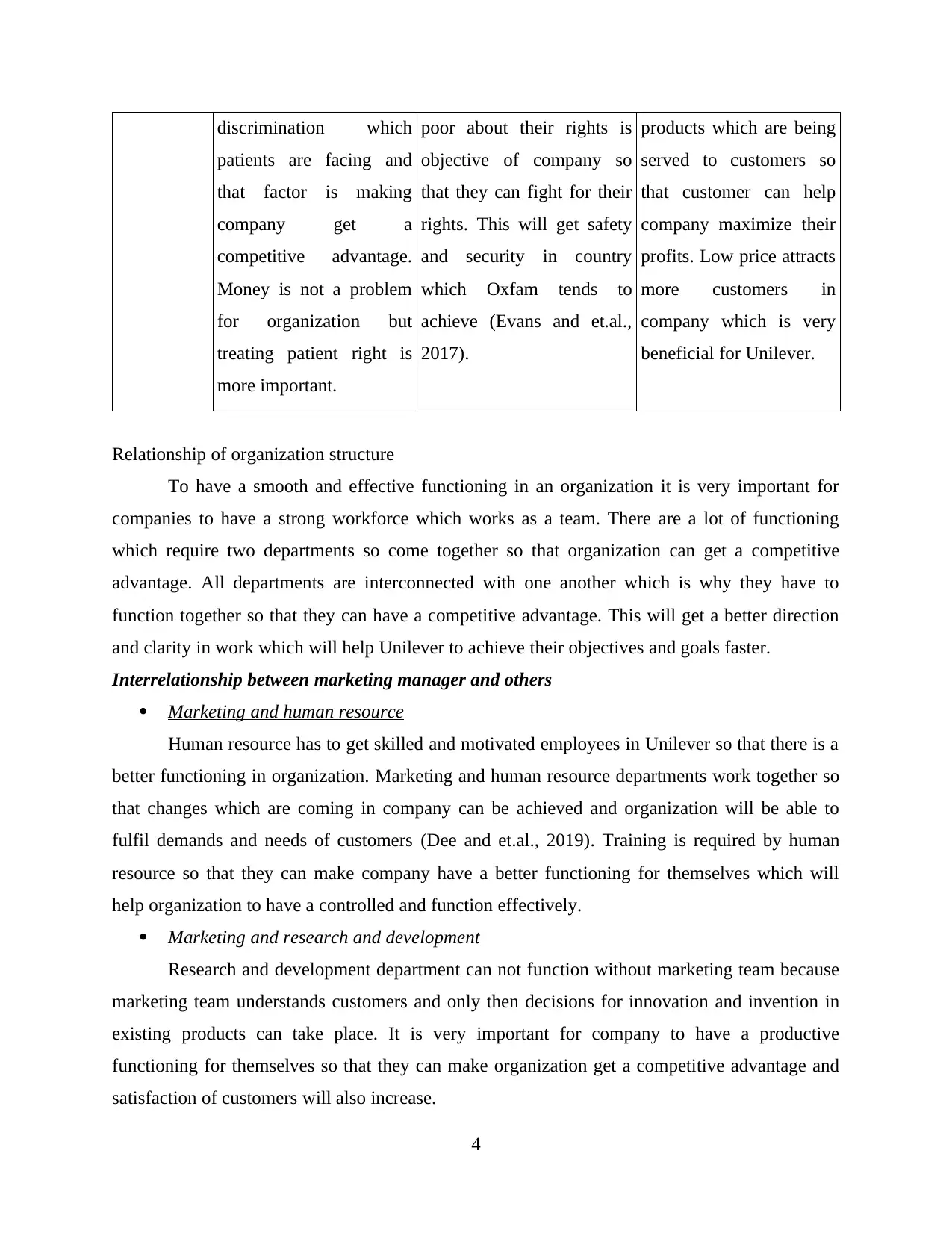
discrimination which
patients are facing and
that factor is making
company get a
competitive advantage.
Money is not a problem
for organization but
treating patient right is
more important.
poor about their rights is
objective of company so
that they can fight for their
rights. This will get safety
and security in country
which Oxfam tends to
achieve (Evans and et.al.,
2017).
products which are being
served to customers so
that customer can help
company maximize their
profits. Low price attracts
more customers in
company which is very
beneficial for Unilever.
Relationship of organization structure
To have a smooth and effective functioning in an organization it is very important for
companies to have a strong workforce which works as a team. There are a lot of functioning
which require two departments so come together so that organization can get a competitive
advantage. All departments are interconnected with one another which is why they have to
function together so that they can have a competitive advantage. This will get a better direction
and clarity in work which will help Unilever to achieve their objectives and goals faster.
Interrelationship between marketing manager and others
Marketing and human resource
Human resource has to get skilled and motivated employees in Unilever so that there is a
better functioning in organization. Marketing and human resource departments work together so
that changes which are coming in company can be achieved and organization will be able to
fulfil demands and needs of customers (Dee and et.al., 2019). Training is required by human
resource so that they can make company have a better functioning for themselves which will
help organization to have a controlled and function effectively.
Marketing and research and development
Research and development department can not function without marketing team because
marketing team understands customers and only then decisions for innovation and invention in
existing products can take place. It is very important for company to have a productive
functioning for themselves so that they can make organization get a competitive advantage and
satisfaction of customers will also increase.
4
patients are facing and
that factor is making
company get a
competitive advantage.
Money is not a problem
for organization but
treating patient right is
more important.
poor about their rights is
objective of company so
that they can fight for their
rights. This will get safety
and security in country
which Oxfam tends to
achieve (Evans and et.al.,
2017).
products which are being
served to customers so
that customer can help
company maximize their
profits. Low price attracts
more customers in
company which is very
beneficial for Unilever.
Relationship of organization structure
To have a smooth and effective functioning in an organization it is very important for
companies to have a strong workforce which works as a team. There are a lot of functioning
which require two departments so come together so that organization can get a competitive
advantage. All departments are interconnected with one another which is why they have to
function together so that they can have a competitive advantage. This will get a better direction
and clarity in work which will help Unilever to achieve their objectives and goals faster.
Interrelationship between marketing manager and others
Marketing and human resource
Human resource has to get skilled and motivated employees in Unilever so that there is a
better functioning in organization. Marketing and human resource departments work together so
that changes which are coming in company can be achieved and organization will be able to
fulfil demands and needs of customers (Dee and et.al., 2019). Training is required by human
resource so that they can make company have a better functioning for themselves which will
help organization to have a controlled and function effectively.
Marketing and research and development
Research and development department can not function without marketing team because
marketing team understands customers and only then decisions for innovation and invention in
existing products can take place. It is very important for company to have a productive
functioning for themselves so that they can make organization get a competitive advantage and
satisfaction of customers will also increase.
4
⊘ This is a preview!⊘
Do you want full access?
Subscribe today to unlock all pages.

Trusted by 1+ million students worldwide
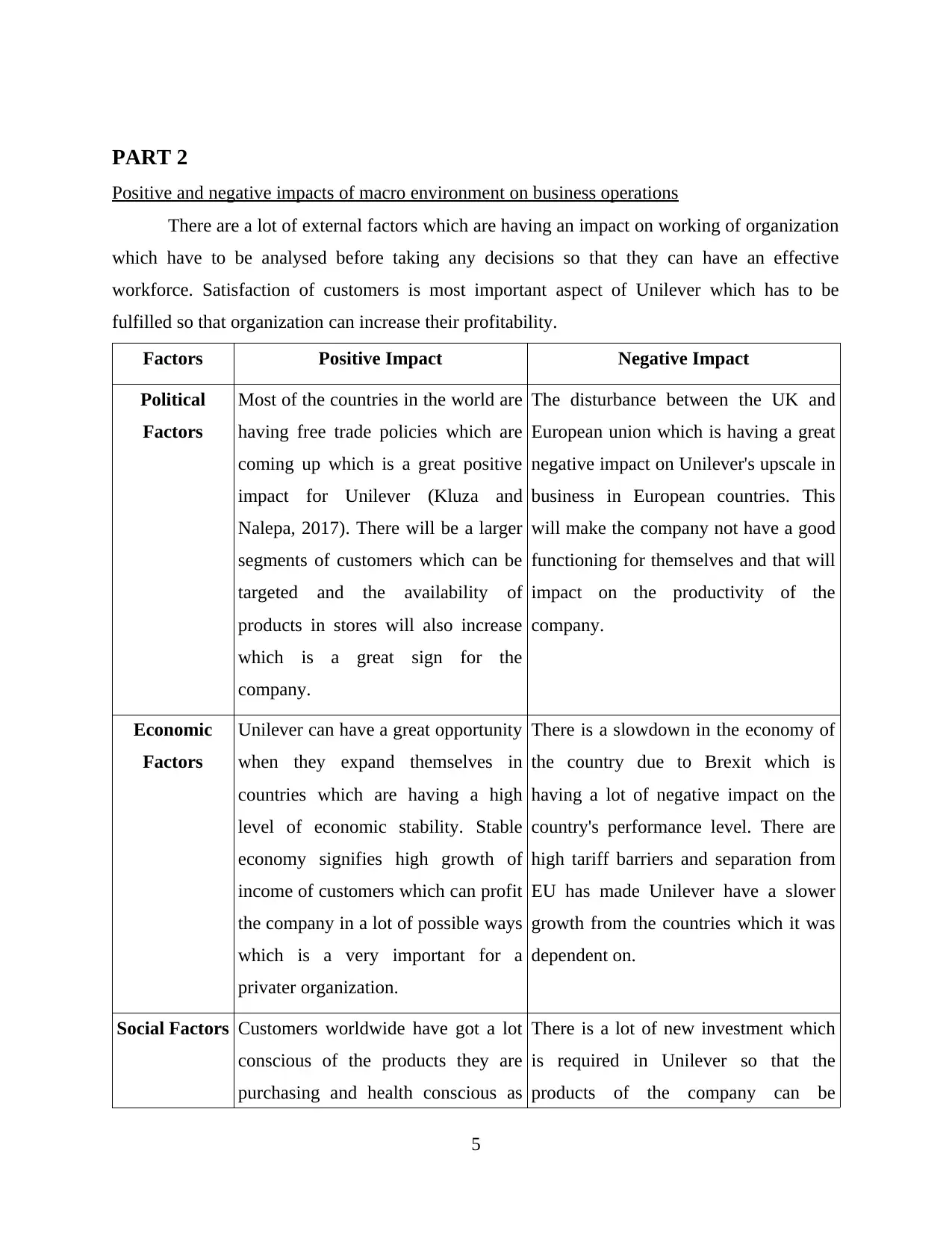
PART 2
Positive and negative impacts of macro environment on business operations
There are a lot of external factors which are having an impact on working of organization
which have to be analysed before taking any decisions so that they can have an effective
workforce. Satisfaction of customers is most important aspect of Unilever which has to be
fulfilled so that organization can increase their profitability.
Factors Positive Impact Negative Impact
Political
Factors
Most of the countries in the world are
having free trade policies which are
coming up which is a great positive
impact for Unilever (Kluza and
Nalepa, 2017). There will be a larger
segments of customers which can be
targeted and the availability of
products in stores will also increase
which is a great sign for the
company.
The disturbance between the UK and
European union which is having a great
negative impact on Unilever's upscale in
business in European countries. This
will make the company not have a good
functioning for themselves and that will
impact on the productivity of the
company.
Economic
Factors
Unilever can have a great opportunity
when they expand themselves in
countries which are having a high
level of economic stability. Stable
economy signifies high growth of
income of customers which can profit
the company in a lot of possible ways
which is a very important for a
privater organization.
There is a slowdown in the economy of
the country due to Brexit which is
having a lot of negative impact on the
country's performance level. There are
high tariff barriers and separation from
EU has made Unilever have a slower
growth from the countries which it was
dependent on.
Social Factors Customers worldwide have got a lot
conscious of the products they are
purchasing and health conscious as
There is a lot of new investment which
is required in Unilever so that the
products of the company can be
5
Positive and negative impacts of macro environment on business operations
There are a lot of external factors which are having an impact on working of organization
which have to be analysed before taking any decisions so that they can have an effective
workforce. Satisfaction of customers is most important aspect of Unilever which has to be
fulfilled so that organization can increase their profitability.
Factors Positive Impact Negative Impact
Political
Factors
Most of the countries in the world are
having free trade policies which are
coming up which is a great positive
impact for Unilever (Kluza and
Nalepa, 2017). There will be a larger
segments of customers which can be
targeted and the availability of
products in stores will also increase
which is a great sign for the
company.
The disturbance between the UK and
European union which is having a great
negative impact on Unilever's upscale in
business in European countries. This
will make the company not have a good
functioning for themselves and that will
impact on the productivity of the
company.
Economic
Factors
Unilever can have a great opportunity
when they expand themselves in
countries which are having a high
level of economic stability. Stable
economy signifies high growth of
income of customers which can profit
the company in a lot of possible ways
which is a very important for a
privater organization.
There is a slowdown in the economy of
the country due to Brexit which is
having a lot of negative impact on the
country's performance level. There are
high tariff barriers and separation from
EU has made Unilever have a slower
growth from the countries which it was
dependent on.
Social Factors Customers worldwide have got a lot
conscious of the products they are
purchasing and health conscious as
There is a lot of new investment which
is required in Unilever so that the
products of the company can be
5
Paraphrase This Document
Need a fresh take? Get an instant paraphrase of this document with our AI Paraphraser
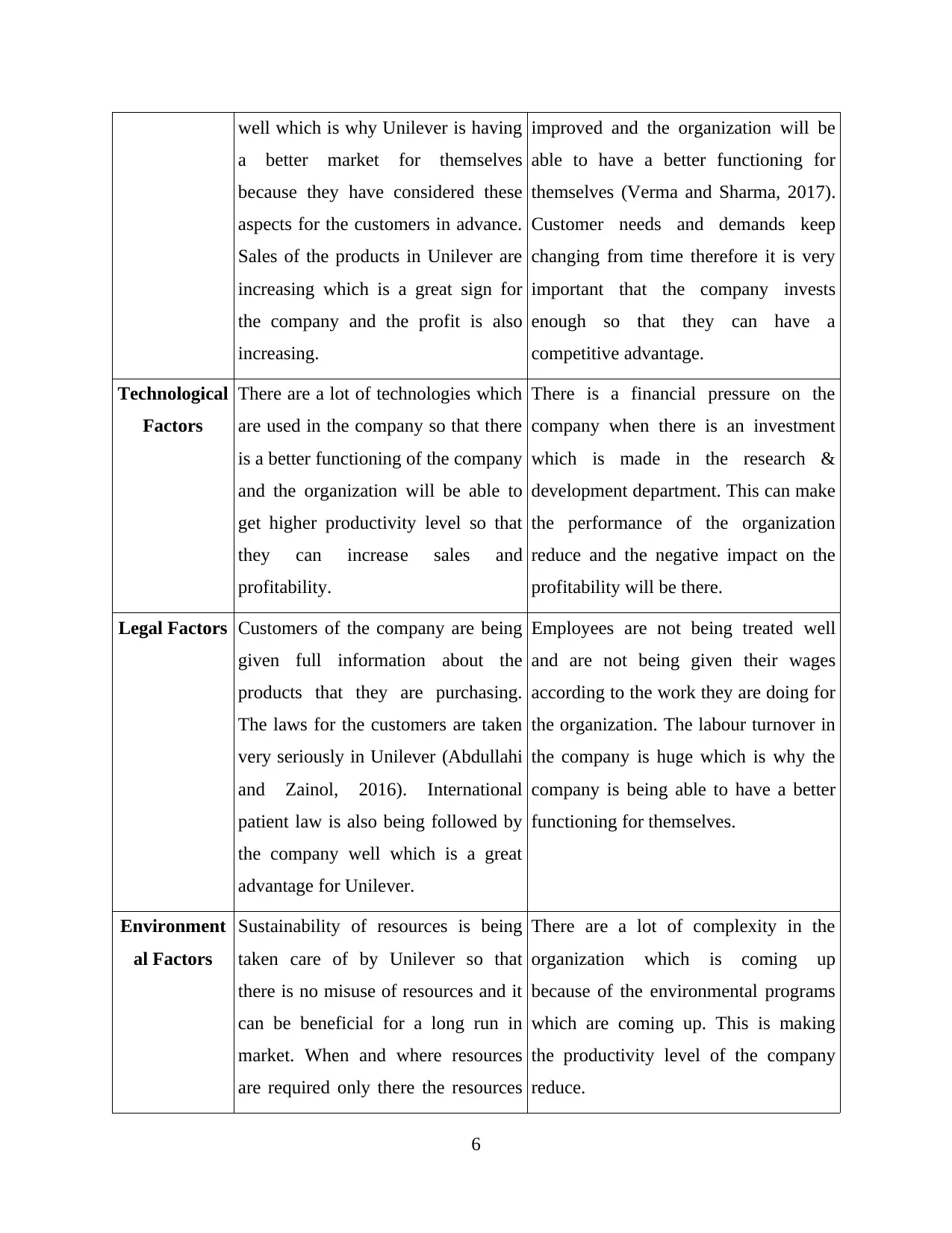
well which is why Unilever is having
a better market for themselves
because they have considered these
aspects for the customers in advance.
Sales of the products in Unilever are
increasing which is a great sign for
the company and the profit is also
increasing.
improved and the organization will be
able to have a better functioning for
themselves (Verma and Sharma, 2017).
Customer needs and demands keep
changing from time therefore it is very
important that the company invests
enough so that they can have a
competitive advantage.
Technological
Factors
There are a lot of technologies which
are used in the company so that there
is a better functioning of the company
and the organization will be able to
get higher productivity level so that
they can increase sales and
profitability.
There is a financial pressure on the
company when there is an investment
which is made in the research &
development department. This can make
the performance of the organization
reduce and the negative impact on the
profitability will be there.
Legal Factors Customers of the company are being
given full information about the
products that they are purchasing.
The laws for the customers are taken
very seriously in Unilever (Abdullahi
and Zainol, 2016). International
patient law is also being followed by
the company well which is a great
advantage for Unilever.
Employees are not being treated well
and are not being given their wages
according to the work they are doing for
the organization. The labour turnover in
the company is huge which is why the
company is being able to have a better
functioning for themselves.
Environment
al Factors
Sustainability of resources is being
taken care of by Unilever so that
there is no misuse of resources and it
can be beneficial for a long run in
market. When and where resources
are required only there the resources
There are a lot of complexity in the
organization which is coming up
because of the environmental programs
which are coming up. This is making
the productivity level of the company
reduce.
6
a better market for themselves
because they have considered these
aspects for the customers in advance.
Sales of the products in Unilever are
increasing which is a great sign for
the company and the profit is also
increasing.
improved and the organization will be
able to have a better functioning for
themselves (Verma and Sharma, 2017).
Customer needs and demands keep
changing from time therefore it is very
important that the company invests
enough so that they can have a
competitive advantage.
Technological
Factors
There are a lot of technologies which
are used in the company so that there
is a better functioning of the company
and the organization will be able to
get higher productivity level so that
they can increase sales and
profitability.
There is a financial pressure on the
company when there is an investment
which is made in the research &
development department. This can make
the performance of the organization
reduce and the negative impact on the
profitability will be there.
Legal Factors Customers of the company are being
given full information about the
products that they are purchasing.
The laws for the customers are taken
very seriously in Unilever (Abdullahi
and Zainol, 2016). International
patient law is also being followed by
the company well which is a great
advantage for Unilever.
Employees are not being treated well
and are not being given their wages
according to the work they are doing for
the organization. The labour turnover in
the company is huge which is why the
company is being able to have a better
functioning for themselves.
Environment
al Factors
Sustainability of resources is being
taken care of by Unilever so that
there is no misuse of resources and it
can be beneficial for a long run in
market. When and where resources
are required only there the resources
There are a lot of complexity in the
organization which is coming up
because of the environmental programs
which are coming up. This is making
the productivity level of the company
reduce.
6
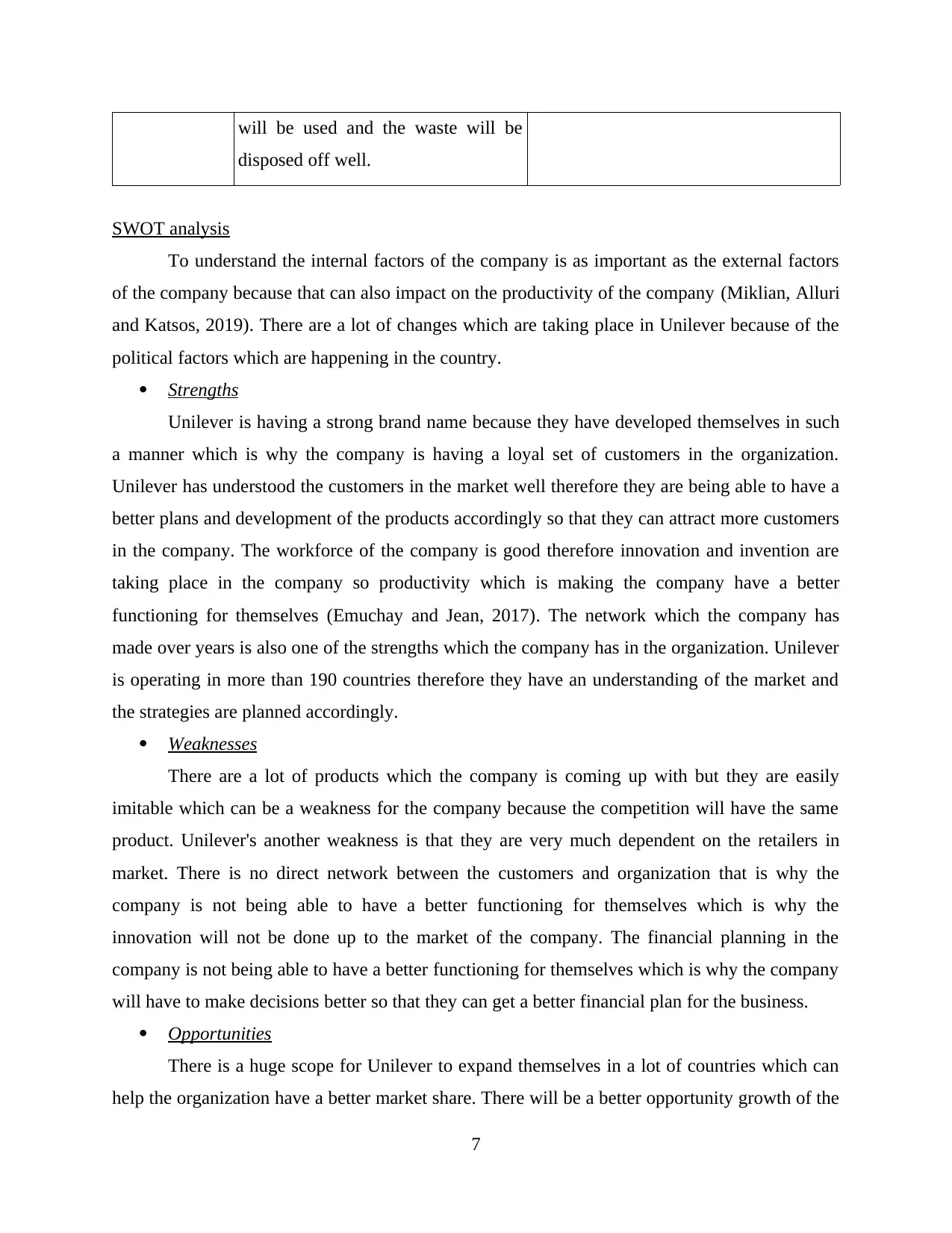
will be used and the waste will be
disposed off well.
SWOT analysis
To understand the internal factors of the company is as important as the external factors
of the company because that can also impact on the productivity of the company (Miklian, Alluri
and Katsos, 2019). There are a lot of changes which are taking place in Unilever because of the
political factors which are happening in the country.
Strengths
Unilever is having a strong brand name because they have developed themselves in such
a manner which is why the company is having a loyal set of customers in the organization.
Unilever has understood the customers in the market well therefore they are being able to have a
better plans and development of the products accordingly so that they can attract more customers
in the company. The workforce of the company is good therefore innovation and invention are
taking place in the company so productivity which is making the company have a better
functioning for themselves (Emuchay and Jean, 2017). The network which the company has
made over years is also one of the strengths which the company has in the organization. Unilever
is operating in more than 190 countries therefore they have an understanding of the market and
the strategies are planned accordingly.
Weaknesses
There are a lot of products which the company is coming up with but they are easily
imitable which can be a weakness for the company because the competition will have the same
product. Unilever's another weakness is that they are very much dependent on the retailers in
market. There is no direct network between the customers and organization that is why the
company is not being able to have a better functioning for themselves which is why the
innovation will not be done up to the market of the company. The financial planning in the
company is not being able to have a better functioning for themselves which is why the company
will have to make decisions better so that they can get a better financial plan for the business.
Opportunities
There is a huge scope for Unilever to expand themselves in a lot of countries which can
help the organization have a better market share. There will be a better opportunity growth of the
7
disposed off well.
SWOT analysis
To understand the internal factors of the company is as important as the external factors
of the company because that can also impact on the productivity of the company (Miklian, Alluri
and Katsos, 2019). There are a lot of changes which are taking place in Unilever because of the
political factors which are happening in the country.
Strengths
Unilever is having a strong brand name because they have developed themselves in such
a manner which is why the company is having a loyal set of customers in the organization.
Unilever has understood the customers in the market well therefore they are being able to have a
better plans and development of the products accordingly so that they can attract more customers
in the company. The workforce of the company is good therefore innovation and invention are
taking place in the company so productivity which is making the company have a better
functioning for themselves (Emuchay and Jean, 2017). The network which the company has
made over years is also one of the strengths which the company has in the organization. Unilever
is operating in more than 190 countries therefore they have an understanding of the market and
the strategies are planned accordingly.
Weaknesses
There are a lot of products which the company is coming up with but they are easily
imitable which can be a weakness for the company because the competition will have the same
product. Unilever's another weakness is that they are very much dependent on the retailers in
market. There is no direct network between the customers and organization that is why the
company is not being able to have a better functioning for themselves which is why the
innovation will not be done up to the market of the company. The financial planning in the
company is not being able to have a better functioning for themselves which is why the company
will have to make decisions better so that they can get a better financial plan for the business.
Opportunities
There is a huge scope for Unilever to expand themselves in a lot of countries which can
help the organization have a better market share. There will be a better opportunity growth of the
7
⊘ This is a preview!⊘
Do you want full access?
Subscribe today to unlock all pages.

Trusted by 1+ million students worldwide
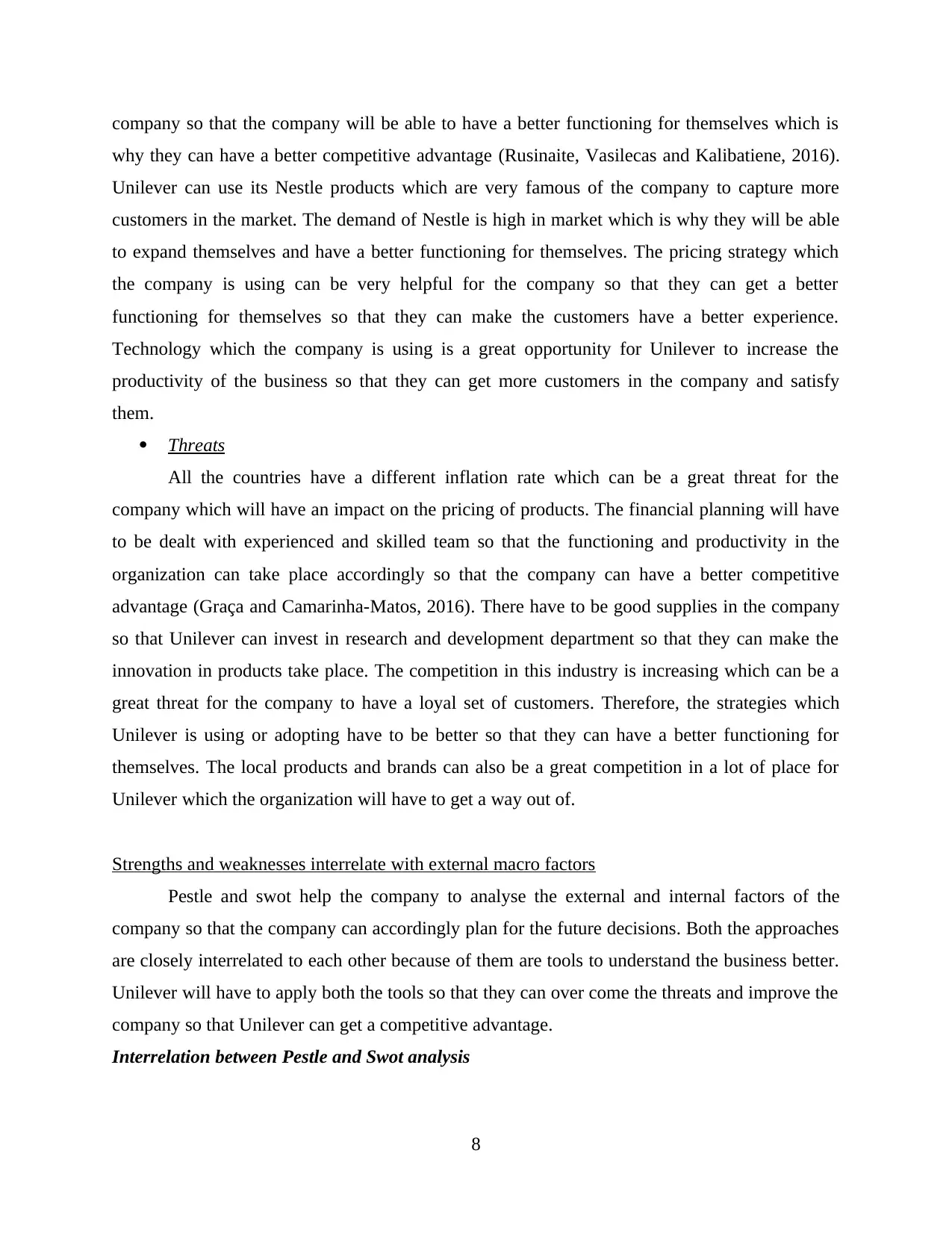
company so that the company will be able to have a better functioning for themselves which is
why they can have a better competitive advantage (Rusinaite, Vasilecas and Kalibatiene, 2016).
Unilever can use its Nestle products which are very famous of the company to capture more
customers in the market. The demand of Nestle is high in market which is why they will be able
to expand themselves and have a better functioning for themselves. The pricing strategy which
the company is using can be very helpful for the company so that they can get a better
functioning for themselves so that they can make the customers have a better experience.
Technology which the company is using is a great opportunity for Unilever to increase the
productivity of the business so that they can get more customers in the company and satisfy
them.
Threats
All the countries have a different inflation rate which can be a great threat for the
company which will have an impact on the pricing of products. The financial planning will have
to be dealt with experienced and skilled team so that the functioning and productivity in the
organization can take place accordingly so that the company can have a better competitive
advantage (Graça and Camarinha-Matos, 2016). There have to be good supplies in the company
so that Unilever can invest in research and development department so that they can make the
innovation in products take place. The competition in this industry is increasing which can be a
great threat for the company to have a loyal set of customers. Therefore, the strategies which
Unilever is using or adopting have to be better so that they can have a better functioning for
themselves. The local products and brands can also be a great competition in a lot of place for
Unilever which the organization will have to get a way out of.
Strengths and weaknesses interrelate with external macro factors
Pestle and swot help the company to analyse the external and internal factors of the
company so that the company can accordingly plan for the future decisions. Both the approaches
are closely interrelated to each other because of them are tools to understand the business better.
Unilever will have to apply both the tools so that they can over come the threats and improve the
company so that Unilever can get a competitive advantage.
Interrelation between Pestle and Swot analysis
8
why they can have a better competitive advantage (Rusinaite, Vasilecas and Kalibatiene, 2016).
Unilever can use its Nestle products which are very famous of the company to capture more
customers in the market. The demand of Nestle is high in market which is why they will be able
to expand themselves and have a better functioning for themselves. The pricing strategy which
the company is using can be very helpful for the company so that they can get a better
functioning for themselves so that they can make the customers have a better experience.
Technology which the company is using is a great opportunity for Unilever to increase the
productivity of the business so that they can get more customers in the company and satisfy
them.
Threats
All the countries have a different inflation rate which can be a great threat for the
company which will have an impact on the pricing of products. The financial planning will have
to be dealt with experienced and skilled team so that the functioning and productivity in the
organization can take place accordingly so that the company can have a better competitive
advantage (Graça and Camarinha-Matos, 2016). There have to be good supplies in the company
so that Unilever can invest in research and development department so that they can make the
innovation in products take place. The competition in this industry is increasing which can be a
great threat for the company to have a loyal set of customers. Therefore, the strategies which
Unilever is using or adopting have to be better so that they can have a better functioning for
themselves. The local products and brands can also be a great competition in a lot of place for
Unilever which the organization will have to get a way out of.
Strengths and weaknesses interrelate with external macro factors
Pestle and swot help the company to analyse the external and internal factors of the
company so that the company can accordingly plan for the future decisions. Both the approaches
are closely interrelated to each other because of them are tools to understand the business better.
Unilever will have to apply both the tools so that they can over come the threats and improve the
company so that Unilever can get a competitive advantage.
Interrelation between Pestle and Swot analysis
8
Paraphrase This Document
Need a fresh take? Get an instant paraphrase of this document with our AI Paraphraser
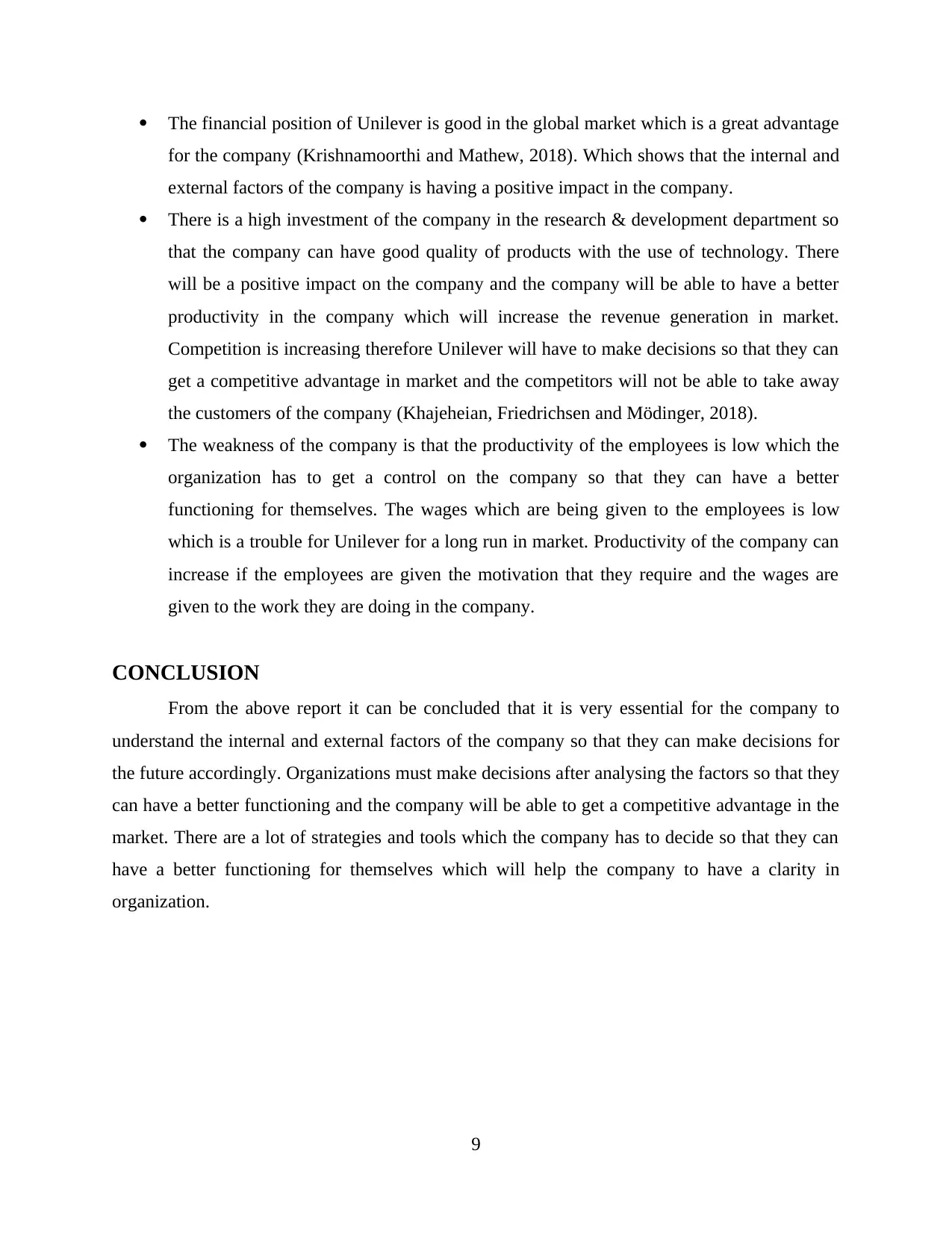
The financial position of Unilever is good in the global market which is a great advantage
for the company (Krishnamoorthi and Mathew, 2018). Which shows that the internal and
external factors of the company is having a positive impact in the company.
There is a high investment of the company in the research & development department so
that the company can have good quality of products with the use of technology. There
will be a positive impact on the company and the company will be able to have a better
productivity in the company which will increase the revenue generation in market.
Competition is increasing therefore Unilever will have to make decisions so that they can
get a competitive advantage in market and the competitors will not be able to take away
the customers of the company (Khajeheian, Friedrichsen and Mödinger, 2018).
The weakness of the company is that the productivity of the employees is low which the
organization has to get a control on the company so that they can have a better
functioning for themselves. The wages which are being given to the employees is low
which is a trouble for Unilever for a long run in market. Productivity of the company can
increase if the employees are given the motivation that they require and the wages are
given to the work they are doing in the company.
CONCLUSION
From the above report it can be concluded that it is very essential for the company to
understand the internal and external factors of the company so that they can make decisions for
the future accordingly. Organizations must make decisions after analysing the factors so that they
can have a better functioning and the company will be able to get a competitive advantage in the
market. There are a lot of strategies and tools which the company has to decide so that they can
have a better functioning for themselves which will help the company to have a clarity in
organization.
9
for the company (Krishnamoorthi and Mathew, 2018). Which shows that the internal and
external factors of the company is having a positive impact in the company.
There is a high investment of the company in the research & development department so
that the company can have good quality of products with the use of technology. There
will be a positive impact on the company and the company will be able to have a better
productivity in the company which will increase the revenue generation in market.
Competition is increasing therefore Unilever will have to make decisions so that they can
get a competitive advantage in market and the competitors will not be able to take away
the customers of the company (Khajeheian, Friedrichsen and Mödinger, 2018).
The weakness of the company is that the productivity of the employees is low which the
organization has to get a control on the company so that they can have a better
functioning for themselves. The wages which are being given to the employees is low
which is a trouble for Unilever for a long run in market. Productivity of the company can
increase if the employees are given the motivation that they require and the wages are
given to the work they are doing in the company.
CONCLUSION
From the above report it can be concluded that it is very essential for the company to
understand the internal and external factors of the company so that they can make decisions for
the future accordingly. Organizations must make decisions after analysing the factors so that they
can have a better functioning and the company will be able to get a competitive advantage in the
market. There are a lot of strategies and tools which the company has to decide so that they can
have a better functioning for themselves which will help the company to have a clarity in
organization.
9
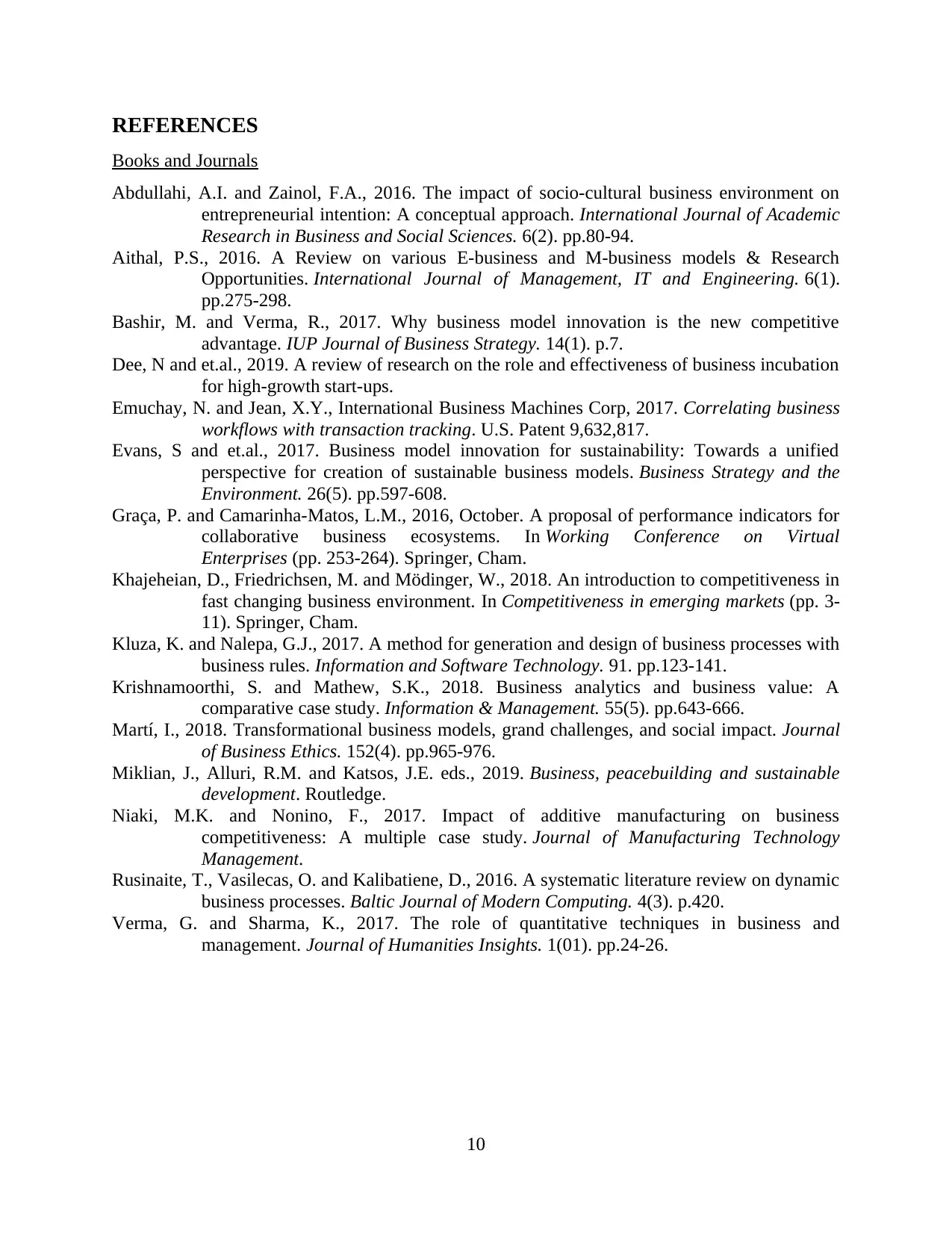
REFERENCES
Books and Journals
Abdullahi, A.I. and Zainol, F.A., 2016. The impact of socio-cultural business environment on
entrepreneurial intention: A conceptual approach. International Journal of Academic
Research in Business and Social Sciences. 6(2). pp.80-94.
Aithal, P.S., 2016. A Review on various E-business and M-business models & Research
Opportunities. International Journal of Management, IT and Engineering. 6(1).
pp.275-298.
Bashir, M. and Verma, R., 2017. Why business model innovation is the new competitive
advantage. IUP Journal of Business Strategy. 14(1). p.7.
Dee, N and et.al., 2019. A review of research on the role and effectiveness of business incubation
for high-growth start-ups.
Emuchay, N. and Jean, X.Y., International Business Machines Corp, 2017. Correlating business
workflows with transaction tracking. U.S. Patent 9,632,817.
Evans, S and et.al., 2017. Business model innovation for sustainability: Towards a unified
perspective for creation of sustainable business models. Business Strategy and the
Environment. 26(5). pp.597-608.
Graça, P. and Camarinha-Matos, L.M., 2016, October. A proposal of performance indicators for
collaborative business ecosystems. In Working Conference on Virtual
Enterprises (pp. 253-264). Springer, Cham.
Khajeheian, D., Friedrichsen, M. and Mödinger, W., 2018. An introduction to competitiveness in
fast changing business environment. In Competitiveness in emerging markets (pp. 3-
11). Springer, Cham.
Kluza, K. and Nalepa, G.J., 2017. A method for generation and design of business processes with
business rules. Information and Software Technology. 91. pp.123-141.
Krishnamoorthi, S. and Mathew, S.K., 2018. Business analytics and business value: A
comparative case study. Information & Management. 55(5). pp.643-666.
Martí, I., 2018. Transformational business models, grand challenges, and social impact. Journal
of Business Ethics. 152(4). pp.965-976.
Miklian, J., Alluri, R.M. and Katsos, J.E. eds., 2019. Business, peacebuilding and sustainable
development. Routledge.
Niaki, M.K. and Nonino, F., 2017. Impact of additive manufacturing on business
competitiveness: A multiple case study. Journal of Manufacturing Technology
Management.
Rusinaite, T., Vasilecas, O. and Kalibatiene, D., 2016. A systematic literature review on dynamic
business processes. Baltic Journal of Modern Computing. 4(3). p.420.
Verma, G. and Sharma, K., 2017. The role of quantitative techniques in business and
management. Journal of Humanities Insights. 1(01). pp.24-26.
10
Books and Journals
Abdullahi, A.I. and Zainol, F.A., 2016. The impact of socio-cultural business environment on
entrepreneurial intention: A conceptual approach. International Journal of Academic
Research in Business and Social Sciences. 6(2). pp.80-94.
Aithal, P.S., 2016. A Review on various E-business and M-business models & Research
Opportunities. International Journal of Management, IT and Engineering. 6(1).
pp.275-298.
Bashir, M. and Verma, R., 2017. Why business model innovation is the new competitive
advantage. IUP Journal of Business Strategy. 14(1). p.7.
Dee, N and et.al., 2019. A review of research on the role and effectiveness of business incubation
for high-growth start-ups.
Emuchay, N. and Jean, X.Y., International Business Machines Corp, 2017. Correlating business
workflows with transaction tracking. U.S. Patent 9,632,817.
Evans, S and et.al., 2017. Business model innovation for sustainability: Towards a unified
perspective for creation of sustainable business models. Business Strategy and the
Environment. 26(5). pp.597-608.
Graça, P. and Camarinha-Matos, L.M., 2016, October. A proposal of performance indicators for
collaborative business ecosystems. In Working Conference on Virtual
Enterprises (pp. 253-264). Springer, Cham.
Khajeheian, D., Friedrichsen, M. and Mödinger, W., 2018. An introduction to competitiveness in
fast changing business environment. In Competitiveness in emerging markets (pp. 3-
11). Springer, Cham.
Kluza, K. and Nalepa, G.J., 2017. A method for generation and design of business processes with
business rules. Information and Software Technology. 91. pp.123-141.
Krishnamoorthi, S. and Mathew, S.K., 2018. Business analytics and business value: A
comparative case study. Information & Management. 55(5). pp.643-666.
Martí, I., 2018. Transformational business models, grand challenges, and social impact. Journal
of Business Ethics. 152(4). pp.965-976.
Miklian, J., Alluri, R.M. and Katsos, J.E. eds., 2019. Business, peacebuilding and sustainable
development. Routledge.
Niaki, M.K. and Nonino, F., 2017. Impact of additive manufacturing on business
competitiveness: A multiple case study. Journal of Manufacturing Technology
Management.
Rusinaite, T., Vasilecas, O. and Kalibatiene, D., 2016. A systematic literature review on dynamic
business processes. Baltic Journal of Modern Computing. 4(3). p.420.
Verma, G. and Sharma, K., 2017. The role of quantitative techniques in business and
management. Journal of Humanities Insights. 1(01). pp.24-26.
10
⊘ This is a preview!⊘
Do you want full access?
Subscribe today to unlock all pages.

Trusted by 1+ million students worldwide
1 out of 12
Related Documents
Your All-in-One AI-Powered Toolkit for Academic Success.
+13062052269
info@desklib.com
Available 24*7 on WhatsApp / Email
![[object Object]](/_next/static/media/star-bottom.7253800d.svg)
Unlock your academic potential
Copyright © 2020–2025 A2Z Services. All Rights Reserved. Developed and managed by ZUCOL.





